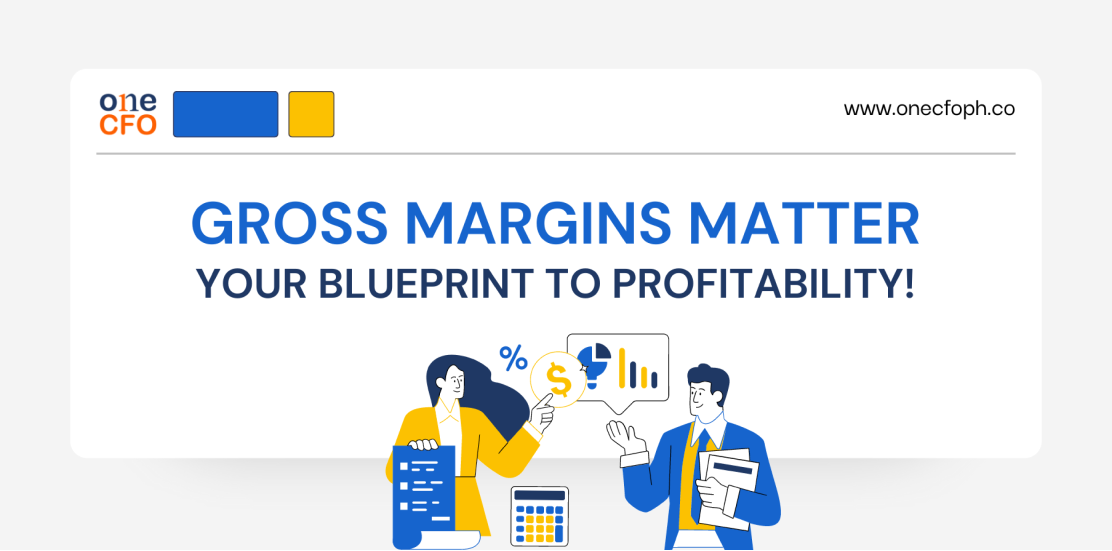
August 28, 2023 | 3:48 pm
Table of Contents
Gross margin is a crucial indicator of a company's financial health, and knowing what
constitutes an excellent gross margin can significantly boost profitability and drive
greater success for SMEs.
You might think, "What's a good gross margin to aim for?" Truth is, there's no
one-size-fits-all answer. The best margin for your business depends on factors like
industry, location, company size, and business goals.
But once you have a target in mind, you can focus on increasing your profitability by
adjusting your pricing, reducing costs, and other strategic measures.
Read on to learn more about gross margin and how you can use it to grow your business
further.
What is gross margin?
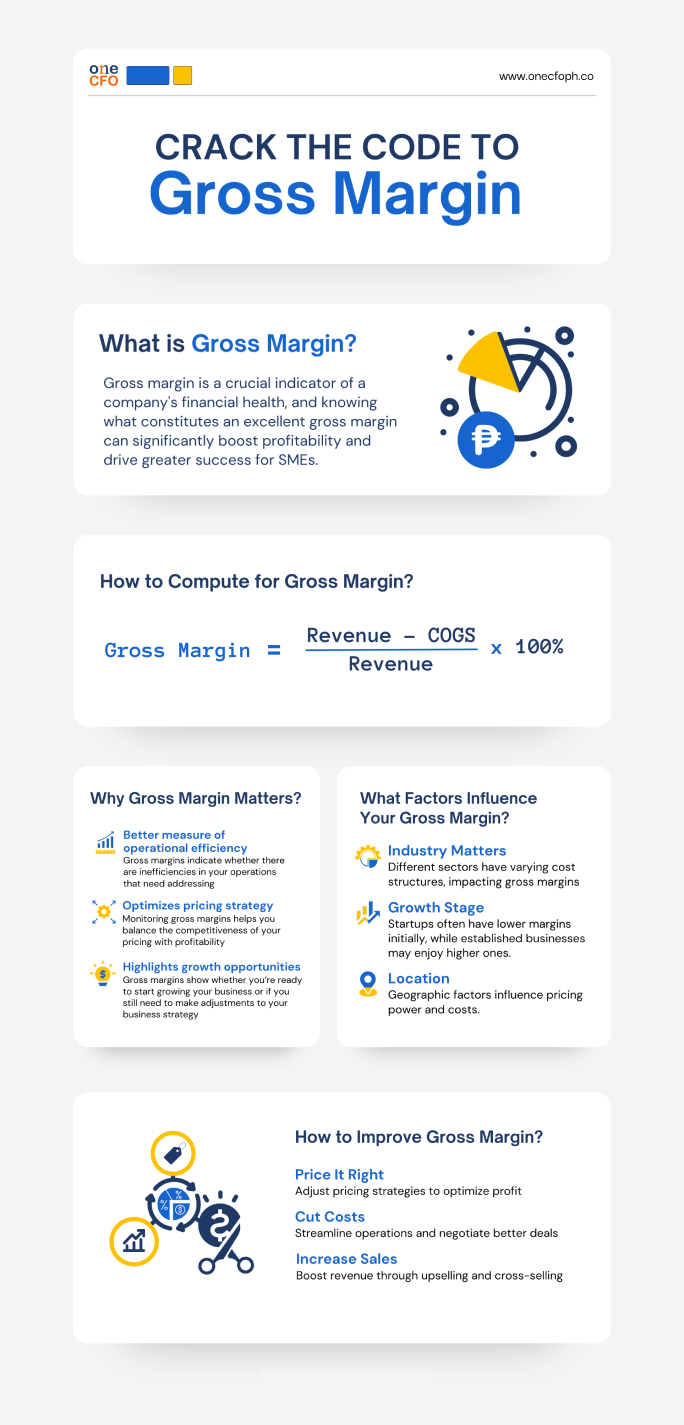
Gross margin or gross profit margin is a key profitability metric that shows the portion or
percentage of revenue left after covering all direct costs of selling your product.
Direct costs, also called costs of goods sold (COGS), include all expenses directly tied to
making or acquiring the business's goods or services. Some examples of COGS are raw
materials, labor wages, and manufacturing overhead.
Monitoring gross margin helps entrepreneurs assess their pricing strategies, exercise
control over costs, and more deeply understand their product or service's profitability.
In addition, gross margin alerts entrepreneurs if they overspend on their raw materials,
labor, or other production costs, which could result in a low gross margin.
How do you calculate gross margin?
Gross margin is a simple metric to calculate, with the formula as follows:
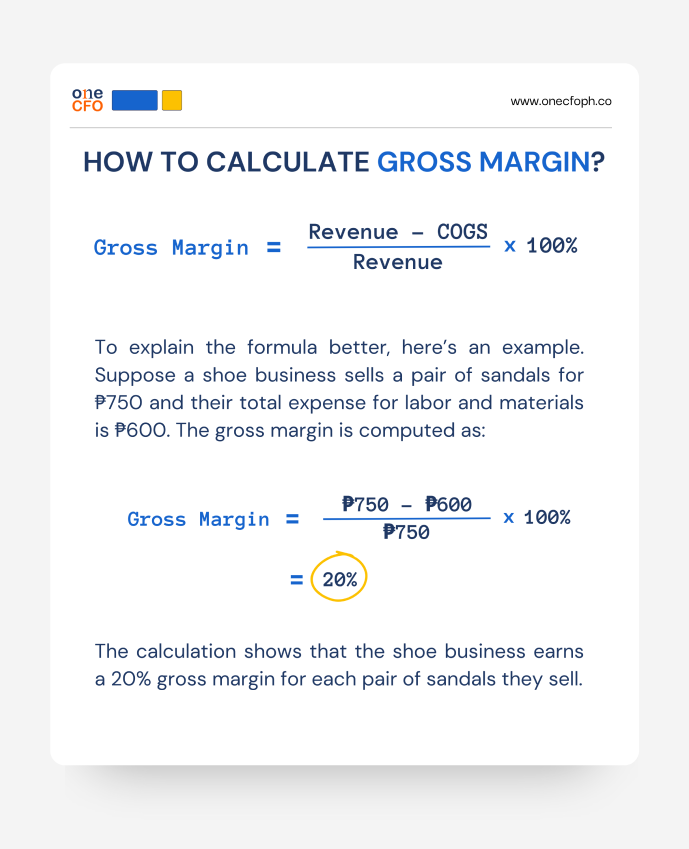
All the data you need to calculate gross margin should be available from your income statement. It’s also worth noting that the initial portion of the formula, Revenue - COGS, represents the gross profit for that sale.
Are gross margin and gross profit the same thing?
Gross profit represents how much money you keep after subtracting COGS from your revenue or
sales. It represents the total profit a company has earned from its core operations.
On the other hand, gross margin considers the relationship between profit and revenue in
percentage form. Gross margin is often used to compare the profitability of different
companies or industries.
From the example above, we can see that subtracting COGS from the revenue, ₱750-₱600,
results in the gross profit, which is ₱150.
Gross margin reflects the percentage of ₱150 to ₱750, representing how much of the total
revenue is gross profit. In this case, the gross margin is 20%, as shown in the above
calculation.
The above example also shows that gross profit is the actual money you make, while the gross
margin is the percentage of your selling price that is profit.
Gross margin vs. Net margin: What’s the difference?
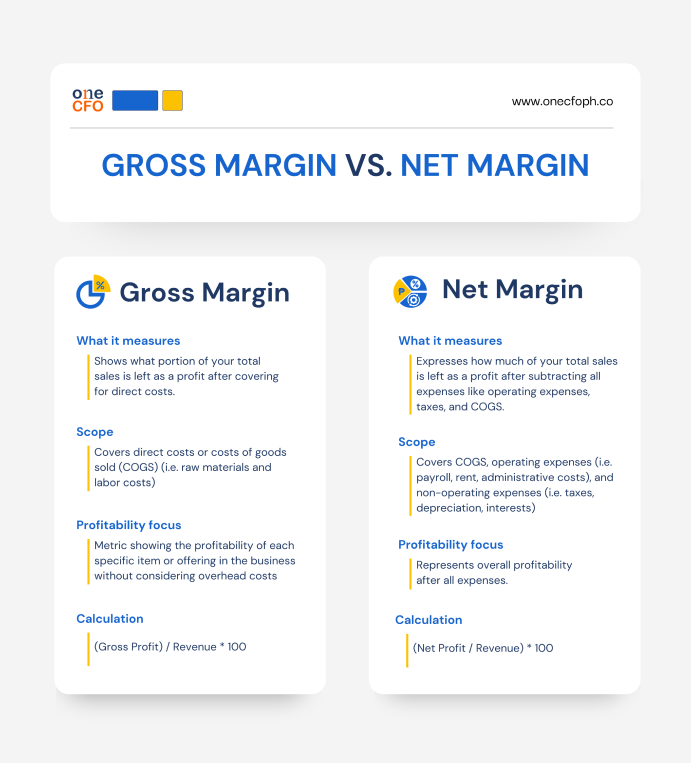
Gross margin is the most commonly used profitability metric, but small business owners
should also know about net margin. Instead of gross profit,
net margin uses net profit and
expresses it as a percentage of revenue.
When calculating net margin, you compute the net profit first by subtracting the following
expenses from the revenue:
The net profit is divided by the revenue to get the net margin. The complete formula for computing net margin is as follows:

Interpreting gross margin also differs from interpreting net margin. Since gross margin only
considers COGS as the expense, it mainly illustrates the profitability of the business's
core offerings.
On the other hand, net margin is used to assess the company's profitability as a whole. It
is a tool to evaluate a business's efficiency across operational and non-operational
aspects.
Why is tracking gross margin important?
Gross margin is more than just a number; it reveals the health of your core business
operations and provides invaluable insights for strategic decision-making.
You can cut costs, optimize pricing, and identify growth opportunities by tracking your
gross margin.
Here are the reasons why tracking gross margin is important for business success:
Better measure of operational efficiency
Gross margin reflects an SME’s operational efficiency, allowing owners to evaluate how much
of their revenue is converted to profit.
A high gross margin indicates effective management of production, inventory, and labor
costs. On the other hand, declining margins could mean issues with the supply chain or
inefficiencies in your process.
As an SME with limited resources, it’s crucial to proactively track your margins and ensure
its operations run smoothly.
Optimizes pricing strategy
One of the complex decisions business owners face is setting the right price for their
products. While it’s common to set prices solely based on market competition, it’s essential
to also consider gross margins in your pricing strategy.
You might feel compelled to keep lowering your prices to outperform competitors, but this
could be harming your business’s financial health.
Factoring in gross margin in your pricing ensures you can cover your production costs while
staying profitable. Regularly monitoring your margins lets you know of whether you need to
adjust prices based on market changes, price fluctuations, or shifts in customer demand.
Highlights growth opportunities
Gross margin indicates whether you’re ready to grow or invest more in your business.
If you plan to hire more people or open a new branch, it’s essential to evaluate your gross
margins to determine whether you can support such growth.
A low gross margin shows that most of your revenue goes to cover operating and
administrative costs, leaving you little money to scale your company.
On the other hand, a consistently high gross margin is a good sign for you to invest back in
the business and further boost your profitability.
What’s a good gross margin for SMEs?
Defining a good gross margin for small businesses can be tricky since many factors influence
this metric. For instance, a 10% gross margin might be fantastic for some businesses but
considered too low for others.
Here are some factors that determine a good gross margin for your specific business:
To determine the best margin for your business, connect with and learn from other entrepreneurs in your industry through networking in trade associations or conferences. Similarly, consulting SME experts and finance professionals can give you more insights into what gross margin to set.
How can gross margins be improved to boost profitability?
Improving your gross margin involves pricing your offering properly and reducing expenses
with every sale to boost profitability.
Here are some tips for SMEs:
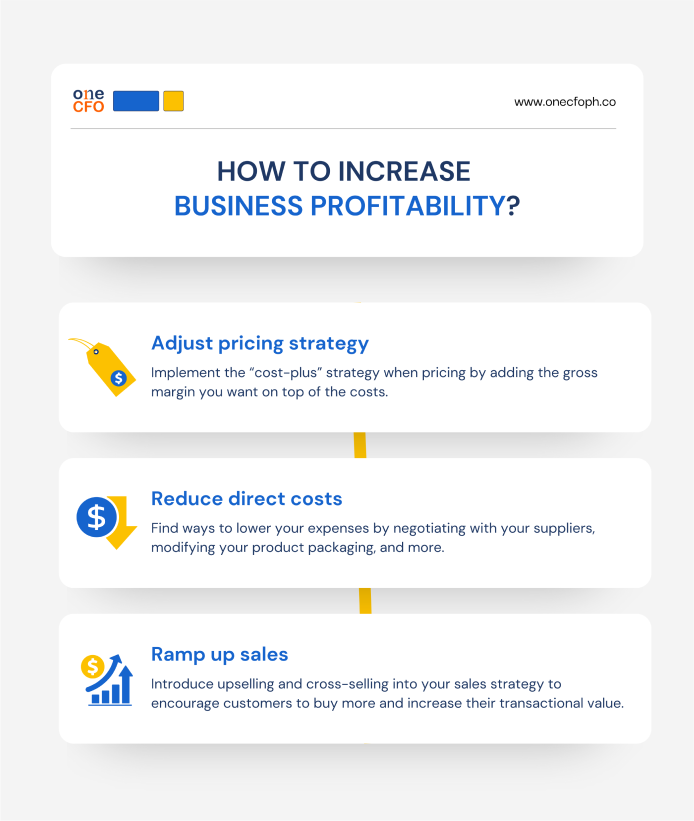
Adjust your pricing strategy
A common strategy for pricing products or services is "cost-plus", which involves setting a
specific gross margin and adding it to your costs to determine the final price.
For example, if each product costs ₱10 to produce and you want a 50% margin, you would price
your product at ₱15.
Apart from cost-plus pricing, other factors to consider when setting a
price include your
market positioning, the economy's state, or competitors' presence.
When adjusting your pricing, be strategic and ensure the change is justified, especially
since increasing prices risks driving customers away.
Learn more about proper pricing by watching this video:
Reduce direct costs
Another effective method for increasing gross margins is to reduce business expenses or
direct costs. A simple way to do this is to review your current expenses and find ways to
eliminate or lower each.
For example, you can reassess your packaging and see if you can downsize your boxes, use
simpler designs, or switch any printed manuals to an online QR code.
You can also decrease expenses by negotiating with suppliers and agreeing on more favorable
terms. For example, you could ask for lower prices when bulk buying materials or request
discounts for early payments.
Ramp up your sales
Once you have addressed the other profitability issues concerning price and costs, you can
now improve profitability by increasing your sales. One way to ramp up your sales is to
leverage upselling and cross-selling in your strategy.
Upselling means encouraging customers to purchase a more expensive version of the product
they’re considering.
For example, laptop stores could train their salespeople to upsell high-end models whenever
someone is buying a basic one. Since customers often lean towards cheaper products,
salespeople can persuade them by highlighting the benefits of the higher-end version and
justifying the additional cost.
Educating customers on the superior features, better performance, and long-term value of the
pricier model can make the higher price more appealing and reasonable.
What is cross-selling?
On the other hand, cross-selling involves recommending complementary products that the
customer might find useful, thereby increasing their overall transaction value.
For example, if a customer buys a laptop, you might recommend a laptop sleeve, a wireless
mouse, or a keyboard.
Offering bundles at a discounted price can also be effective as long as you maintain good
profitability on all the items. This approach not only enhances the customer’s experience
but also boosts your sales.
Boost your bottom line through gross margin optimization
As the saying goes, “You can’t improve what you don’t measure.”
One effective way SMEs can boost their profitability is to regularly calculate, track, and
improve their gross margin. Achieving the right gross margin ensures you cover all costs and
have sufficient funds for growth.
If you're at a loss on what gross margin to target or how to increase it, don't worry—OneCFO
is here to help!
Our team of highly skilled finance experts is ready to help entrepreneurs like you elevate
their business. Working with OneCFO, world-class financial insights and advice are at your
fingertips, guiding you to set optimal profit margins and develop strategies to achieve
them.
Visit us at onecfoph.co or email us at [email protected] to
learn how we can help SMEs
manage and enhance their profitability.
Read our disclaimer here.